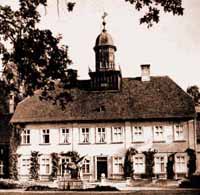“Every man in East Prussia

Stud farm courtesy www.trakehners-interanational.com.


Trakehnen, a town in the Gumbinnen district of East Prussia,
was home to one of the biggest agricultural farms in the province. It housed 900 cows, 600 sheep and thousands
of horses. King Friedrich Wilhelm I
ordered 1100 horses for Trakehnen. With
a 400 year history, the Trakehner horse, bred in East
Prussia , was the oldest of the warmblood breeds. The oldest existing German stud book dates
back to 1623.
The Trakehner was a tall
horse at 15.2 to 17 hands. It came in
the colours bay, gray, chestnut and black.
It had great versatility and endurance.
A horse was treated like a king at Trakehnen: it galloped all over a paddock encircled by
trees rather than fences. It was well
fed, well groomed and well trained.
While
it was engineered as an East Prussian workhorse, it was also used for fox
hunting, racing and as a calvary mount; in fact it was the horse of choice for
German officers. Trakehners carried
soldiers into battle at Waterloo
against Napoleon in 1814. During the
battle and its aftermath, Prussia
lost 75,000 horses, many of which ended up in Russia . The Trakehner was sought after by the
military in other European countries too.
By 1918, 60,000 mares were bred to East Prussian stallions each
year.
Trakehners competed in every
Olympic Games but 1932. In 1924, Trakenher Piccolomini won gold and
Sabel won silver, both in the dressage event.
Nine thirty six was declared
“The Year of the Trakehner” in which the breed won a gold medal in dressage
(Kronos) as well as a silver medal in dressage (Sabel). Trakehners also won the three day eventing
gold medal at the Olympics along with the German Jumping Team Prix des
Nations. Between 1921 and 1936 Trakehners
won the Czech Steeplechase nine times.
Sadly, many of the breed were killed in battle during the First World
War, its numbers cut in half. Even more
Trakehners were killed, froze to death or succumbed to disease during the
Second World War, bringing it to near extinction (179,000 on the Eastern Front
alone). In fact, 80 % of the Germany
Army rode on horseback. The Trakehners
pulled everything the soldiers needed either on horseback or by wagon. The Germans could not mass produce
automobiles the way the Americans did and did not have the same easy access to
fuel. The hundreds of thousands of
horses needed the support of 37000 farriers and 236 companies of vets, the
latter treating them and returning 70 to 75% of them to the battlefield.
Eight hundred of the best mares were evacuated to the West in October of 1944 when the Red Army was on East Prussia's doorstep. Many East Prussian refugees mounted
Trakehners for the 600 mile journey to safety, the Red Army at their
heels. Many suffered open wounds from
shrapnel and the burlap bags froze to their feet. Their horses often starved, drowned, froze to
death, were shot or captured by the Russians.
The captured horses were taken to Kirov ;
these horses would become the ancestors of the Russian Trakehner. The English Army took the best black and
chestnut colts for the Royal Cavalry in London . Out of 25,000 broadmares and 1200 stallions,
only 1500 reached their destination in Germany
proper. The last original Trakehner was “Keith” who
was born in 1941 and died in 1976. The
East Prussian Studbook Society dissolved on October 23, 1947 .
The Big Trek courtesy codoh.com.

Fascinating!
ReplyDelete